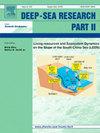来自两个CMIP6模式的大西洋上升流细胞未来趋势的空间变化
IF 3
3区 地球科学
Q2 OCEANOGRAPHY
Deep-sea Research Part Ii-topical Studies in Oceanography
Pub Date : 2025-05-08
DOI:10.1016/j.dsr2.2025.105483
引用次数: 0
摘要
东部边界上升流系统(EBUS)的特点是由风引发的沿海深水上升流。它们是生物生产力和多样性的热点,因此具有很高的经济、生态和社会重要性。在过去,利用地表数据的不同方法被用来估计上升流。最近,IPCC建议直接评估垂直速度是一种很有前途的方法。我们利用该方法研究了来自HadGEM3-GC3.1和CNRM6-CM6家族的CMIP6模式在历史时期和未来高排放情景下的两个大西洋EBUS,海洋分量的空间分辨率在1°到1/12°之间。两个主要的上升流区域根据其季节性划分为次区域。垂直输送指数与由风引起的Ekman指数值相似。直接评估来自运输过程的上升流进一步提供了有关上升流深度的信息,而上升流深度先前已被确定为营养可利用性的一个重要因素。我们表明,根据上升流系统的子区域,可以在深度和到最大速度海岸的距离方面看到不同的单元结构。在考虑未来可能的变化时,年际高变率限制了趋势的重要性,但可能表明上升流区域向极地移动。空间结构的详细比较和分区的区分对于解释以往作品中的矛盾趋势是重要的。本文章由计算机程序翻译,如有差异,请以英文原文为准。
Spatial variation of future trends in Atlantic upwelling cells from two CMIP6 models
Eastern Boundary Upwelling Systems (EBUS) are characterized by wind-triggered upwelling of deep waters along the coast. They are hotspots of biological productivity and diversity and therefore have a high economic, ecological and social importance. In the past, different methods using surface data have been used to estimate upwelling. Recently, the IPCC has suggested directly assessing vertical velocities as a promising method. We use this method to study the two Atlantic EBUS from CMIP6 models from the HadGEM3-GC3.1 and the CNRM6-CM6 family, for both the historical period and a high-emission future scenario with spatial resolutions in the ocean component ranging from 1°to 1/12°. The two major upwelling regions are divided in subregions depending on their seasonality. The vertical transport index shows similar values to a wind-derived Ekman index. Directly evaluating upwelling from transport processes further provides information about the depth of the upwelling, which has previously been identified as an important factor for nutrient availability. We show that depending on the subregion of the upwelling system, different cell structures can be seen in terms of depth and distance to the coast of maximum velocities. When looking at possible future changes, high interannual variability limits the significance of the trends but could indicate a poleward shift of the upwelling regions. A detailed comparison of the spatial structures and the distinction in subregions is important to explain contradictory trends in previous works.
求助全文
通过发布文献求助,成功后即可免费获取论文全文。
去求助
来源期刊
CiteScore
6.40
自引率
16.70%
发文量
115
审稿时长
3 months
期刊介绍:
Deep-Sea Research Part II: Topical Studies in Oceanography publishes topical issues from the many international and interdisciplinary projects which are undertaken in oceanography. Besides these special issues from projects, the journal publishes collections of papers presented at conferences. The special issues regularly have electronic annexes of non-text material (numerical data, images, images, video, etc.) which are published with the special issues in ScienceDirect. Deep-Sea Research Part II was split off as a separate journal devoted to topical issues in 1993. Its companion journal Deep-Sea Research Part I: Oceanographic Research Papers, publishes the regular research papers in this area.

 求助内容:
求助内容: 应助结果提醒方式:
应助结果提醒方式:


